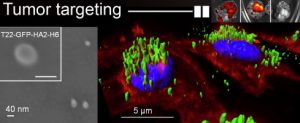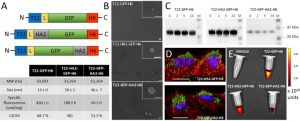https://doi.org/10.1016/j.actbio.2019.09.002


Abstract
By the appropriate selection of functional peptides and proper accommodation sites, we have generated a set of multifunctional proteins that combine selectivity for CXCR4+ cell binding and relevant endosomal escape capabilities linked to the viral peptide HA2. In particular, the construct T22-GFP-HA2-H6 forms nanoparticles that upon administration in mouse models of human, CXCR4+ colorectal cancer, accumulates in primary tumor at levels significantly higher than the parental T22-GFP-H6 HA2-lacking version. The in vivo application of a CXCR4 antagonist has confirmed the prevalence of the CXCR4+tumor tissue selectivity over unspecific cell penetration, upon systemic administration of the material. Such specificity is combined with improved endosomal escape, what overall results in a precise and highly efficient tumor biodistribution. These data strongly support the functional recruitment as a convenient approach to generate protein materials for clinical applications. More precisely, they also support the unexpected concept that enhancing the unspecific membrane activity of a protein material does not necessarily compromise, but it can even improve, the selective cell targeting offered by an accompanying functional module.
Statement of significance
We have shown here that the combination of cell-penetrating and tumor cell targeting peptides in single-protein nanoparticles dramatically enhances precise tumor accumulation of protein-only nanoparticles intended for selective drug delivery, in mouse models of human colorectal cancer. This fact is a step forward for the rational design of multifunctional protein nanomaterials for improved cancer therapies.
